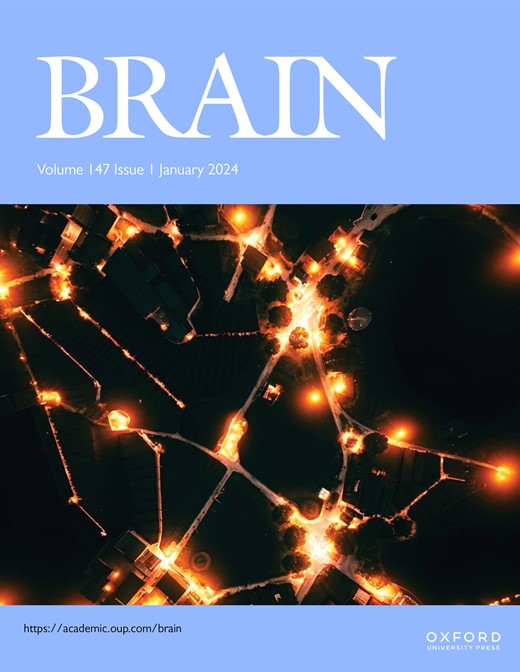Mitochondrial damage is associated with an early immune response in inclusion body myositis
IF 10.6
1区 医学
Q1 CLINICAL NEUROLOGY
引用次数: 0
Abstract
Polymyositis with mitochondrial pathology (PM-Mito) was first identified in 1997 as a subtype of idiopathic inflammatory myopathy. Recent findings demonstrated significant molecular similarities between PM-Mito and Inclusion Body Myositis (IBM), suggesting a trajectory from early to late IBM and prompting the inclusion of PM-Mito as an IBM precursor (early IBM) within the IBM spectrum. Both PM-Mito and IBM show mitochondrial abnormalities, suggesting mitochondrial disturbance is a critical element of IBM pathogenesis. The primary objective of this cross-sectional study was to characterize the mitochondrial phenotype in PM-Mito at histological, ultrastructural, and molecular levels and to study the interplay between mitochondrial dysfunction and inflammation. Skeletal muscle biopsies of 27 patients with PM-Mito and 27 with typical IBM were included for morphological and ultrastructural analysis. Mitochondrial DNA (mtDNA) copy number and deletions were assessed by qPCR and long-range PCR, respectively. In addition, full-length single-molecule sequencing of the mtDNA enabled precise mapping of deletions. Protein and RNA levels were studied using unbiased proteomic profiling, immunoblotting, and bulk RNA sequencing. Cell-free mtDNA (cf-mtDNA) was measured in the serum of IBM patients. We found widespread mitochondrial abnormalities in both PM-Mito and IBM, illustrated by elevated numbers of COX-negative and SDH-positive fibers and prominent ultrastructural abnormalities with disorganized and concentric cristae within enlarged and dysmorphic mitochondria. MtDNA copy numbers were significantly reduced, and multiple large-scale mtDNA deletions were already evident in PM-Mito, compared to healthy age-matched controls, similar to the IBM group. The canonical cGAS/STING inflammatory pathway was activated in PM-Mito and IBM, and we detected elevated levels of circulating cf-mtDNA indicative of mtDNA leakage. In PM-Mito and IBM, these findings were accompanied by dysregulation of proteins and transcripts linked to the mitochondrial membranes. In summary, we identified that mitochondrial dysfunction with multiple mtDNA deletions and depletion, disturbed mitochondrial ultrastructure, and defects of the inner mitochondrial membrane are features of PM-Mito and IBM, underlining the concept of an IBM-spectrum disease (IBM-SD). Notably, mitochondrial abnormalities precede tissue remodeling and infiltration by specific T-cell subpopulations (e.g., KLRG1+) characteristic of late IBM. The activation of inflammatory, DNA-sensing pathways might be related to mtDNA release, which would indicate a significant role of mitochondria-associated inflammation in the pathogenesis of IBM-SD. This study highlights the critical role of early mitochondrial abnormalities in the pathomechanism of IBM, which may lead to new approaches to therapy.线粒体损伤与包涵体肌炎的早期免疫反应有关
多发性肌炎伴线粒体病理(PM-Mito)于1997年首次被确定为特发性炎性肌病的一种亚型。最近的研究结果表明,PM-Mito和内含体肌炎(IBM)之间存在显著的分子相似性,表明从早期到晚期IBM的发展轨迹,并促使PM-Mito作为IBM谱系中的IBM先驱(早期IBM)被纳入。PM-Mito和IBM均显示线粒体异常,表明线粒体紊乱是IBM发病机制的关键因素。本横断面研究的主要目的是在组织学、超微结构和分子水平上表征PM-Mito的线粒体表型,并研究线粒体功能障碍与炎症之间的相互作用。对27例PM-Mito患者和27例典型IBM患者的骨骼肌活检进行形态学和超微结构分析。分别用qPCR和远程PCR检测线粒体DNA拷贝数和缺失量。此外,mtDNA的全长单分子测序能够精确定位缺失。使用无偏蛋白质组学分析、免疫印迹和大量RNA测序研究蛋白质和RNA水平。检测IBM患者血清中游离mtDNA (cf-mtDNA)。我们在PM-Mito和IBM中发现了广泛的线粒体异常,表现为cox阴性和sdh阳性纤维数量的增加,以及在扩大和畸形的线粒体中出现组织紊乱和同心嵴的显著超微结构异常。与年龄匹配的健康对照组相比,PM-Mito的MtDNA拷贝数显著减少,并且多次大规模的MtDNA缺失已经很明显,与IBM组相似。PM-Mito和IBM的典型cGAS/STING炎症途径被激活,我们检测到循环中cf-mtDNA水平升高,表明mtDNA泄漏。在PM-Mito和IBM中,这些发现伴随着与线粒体膜相关的蛋白质和转录本的失调。总之,我们发现线粒体功能障碍包括多个mtDNA缺失和缺失,线粒体超微结构紊乱以及线粒体内膜缺陷是PM-Mito和IBM的特征,强调了IBM谱系疾病(IBM- sd)的概念。值得注意的是,线粒体异常先于组织重塑和特定t细胞亚群(如KLRG1+)的浸润,这是晚期IBM的特征。炎症、dna感应通路的激活可能与mtDNA的释放有关,这可能表明线粒体相关炎症在IBM-SD的发病机制中起着重要作用。这项研究强调了早期线粒体异常在IBM的病理机制中的关键作用,这可能会导致新的治疗方法。
本文章由计算机程序翻译,如有差异,请以英文原文为准。
求助全文
约1分钟内获得全文
求助全文
来源期刊

Brain
医学-临床神经学
CiteScore
20.30
自引率
4.10%
发文量
458
审稿时长
3-6 weeks
期刊介绍:
Brain, a journal focused on clinical neurology and translational neuroscience, has been publishing landmark papers since 1878. The journal aims to expand its scope by including studies that shed light on disease mechanisms and conducting innovative clinical trials for brain disorders. With a wide range of topics covered, the Editorial Board represents the international readership and diverse coverage of the journal. Accepted articles are promptly posted online, typically within a few weeks of acceptance. As of 2022, Brain holds an impressive impact factor of 14.5, according to the Journal Citation Reports.
 求助内容:
求助内容: 应助结果提醒方式:
应助结果提醒方式:


